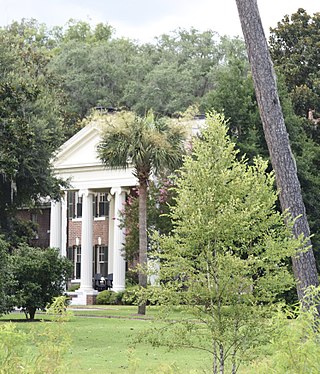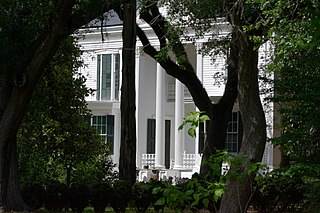
Staunton River State Park is a state park in Virginia. One of the Commonwealth's original state parks, built by the Civilian Conservation Corps and opening in 1936, it is located along the Staunton River near Scottsburg, Virginia. It is an International Dark Sky Park.

Rose Hill Plantation State Historic Site is a historic site in Union County, South Carolina, that preserves the home of William H. Gist (1807-1874), the 68th governor of South Carolina. Gist helped instigate a Secession Convention in South Carolina, which led to the creation of the Ordinance of Secession that preceded the Civil War.
McGregor, now located on SR 547 in Port Gibson, Mississippi, is a country house built in 1835. It was designed in Greek Revival style. It is privately owned and not open to the public.

Oakley Hill is a historic plantation house located near Mechanicsville, Hanover County, Virginia. It was built about 1839 and expanded in the 1850s. It is a two-story, frame I-house dwelling in the Greek Revival style. On the rear of the house is a 1910 one-story ell. The house sits on a brick foundation, has a standing seam metal low gable roof, and interior end chimneys. The front facade features a one-story front porch with four Tuscan order columns and a Tuscan entablature. Also on the property are a contributing smokehouse and servants' house.
The Kilauea Plantation or Kilauea Sugar Plantation was a large sugarcane plantation on the north side of Kauai island, Hawaii, including the community of Kilauea, Hawaii. It was owned and operated by the 1880-incorporated Kilauea Sugar Company, which became the Kilauea Sugar Plantation, Co. from 1899 on. The original property was bought by an American, Charles Titcomb, from Kamehameha IV by 1863 who used it for cattle ranching. It was sold to Englishmen John Ross and E.P. Adams, who also leased additional land from Titcomb. Ross and Adams planted sugarcane, then incorporated a firm. It was operated as a plantation from 1880 to 1971.
The Pine Bloom Plantation, also known as Pinebloom Plantation, is a historic site in Newton, Georgia. It was added to the National Register of Historic Places on February 9, 1990. It is located on Tarva Road and County Route 122, 3/4 of a mile south of the Baker County, Georgia/ Dougherty County, Georgia line in Baker County. The site includes Greek Revival architecture, is associated with Gov. Alfred Holt Colquitt, and dates to about 1850. The plantation was purchased by billionaire John M. Harbert of Birmingham, Alabama in 1981.
Orange Grove Plantation is a historic plantation house and national historic district located on Saint Helena Island near Frogmore, Beaufort County, South Carolina. The district encompasses one contributing building and two contributing sites, and reflects the early-20th century influx of Northerners onto St. Helena Island. The plantation was first recorded in 1753 when Peter Perry purchased 473 acres. Perry owned 46 chattel slaves. The plantation house, built about 1800, was in poor condition when Henry L. Bowles (1866-1932), a U.S. Representative from Massachusetts, bought the property in 1928. He demolished it and built the present house in the same year. The property also includes the tabby ruin of the kitchen, built about 1800, and a tabby-walled cemetery containing three early-19th century graves of the Fripp and Perry families.

Johnson's Woods is a historic plantation house in Tuscumbia, Alabama. The house was built in 1837 on land purchased by George W. Carroll in 1828. A settler from Maryland, Carroll became the county's wealthiest planter by 1850. Between 1855 and 1860, he moved to Arkansas, selling his plantation to William Mhoon. Upon Mhoon's death in 1869, the plantation passed to William A. Johnson, a former Tennessee River steamboat operator and Confederate Army soldier. In addition to farming, Johnson also revived his steamboat business, traded cotton in Memphis, and opened a mercantile business in Tuscumbia. After his death in 1891 and his wife's in 1905, the land passed to his son, John W. Johnson.
The Battleground Plantation is a Southern plantation with a historic mansion located about 3.2 miles (5.1 km) north of the town of Sicily Island in Catahoula Parish, Louisiana. It was listed on the National Register of Historic Places in 1979.
The Dulcito Plantation is a historic house built c. 1850, and formally was a Southern plantation, located at 5918 West Old Spanish Trail in New Iberia, Louisiana. This is one of the few remaining buildings of the area that highlights the pre-Civil War architectural heritage, despite having some alterations. The house was listed on the National Register of Historic Places on July 22, 1994.
Box Hall Plantation in Thomasville, Georgia is notable for its main house built in Georgian Revival style designed by New York architects Delano & Aldrich and built during 1930–31. It replaced the first "big house", named Box Hall, which was built on the property in 1857 by A. T. MacIntyre and his wife, the former America Young. That house was lost in a fire around 1929.

The Albert Neal Durden House, also known as the Durden-Brinson-Brewer House, is located in Emanuel County, Georgia near Twin City, Georgia. It was listed on the National Register of Historic Places with three contributing buildings, a contributing structure, and three non-contributing buildings on 162 acres (66 ha) in 1990.

The Hollywood Plantation in Thomasville, Georgia was listed on the National Register of Historic Places in 2003. It is a 38 acres (15 ha) property with four contributing buildings, including its main house which is a Colonial Revival-style mansion built in 1928.
The Melrose and Sinkola Plantations, in Thomas County, Georgia, a property of 1,500 acres (610 ha), was listed on the National Register of Historic Places in 1990.

Birdsville Plantation, in Birdsville, Jenkins County, Georgia near Millen, is a 50 acres (20 ha) property which was listed on the National Register of Historic Places in 1971. It then included 10 contributing buildings. It is a National Bicentennial Farm.

The Estate Carolina Sugar Plantation near Coral Bay on Saint John, U.S. Virgin Islands is a historic sugar plantation and later rum distillery.

Whim is a historic sugar plantation located in Southwest subdistrict about 1.7 miles (2.7 km) southeast of Frederiksted on Centerline Road on Saint Croix, U.S. Virgin Islands. It was listed on the National Register of Historic Places in 1976. The listing included three contributing buildings, one contributing site, and two contributing structures, on 10 acres (4.0 ha).
Brown Bay is a bay and a former sugar cane and cotton plantation in the Virgin Islands National Park on the island of Saint John, U.S. Virgin Islands. It is on the north shore of eastern end of the island, north of the settlement of Palestina.
The More Hill Historic District in the East End area of Saint John in the U.S. Virgin Islands, was listed on the National Register of Historic Places in 1981.

The Davis-Felton Plantation, near Henderson in Houston County, Georgia, is a plantation that was listed on the National Register of Historic Places in 1979. It is located northwest of Henderson on Felton Rd. The plantation was also known as Mossy Hill.











